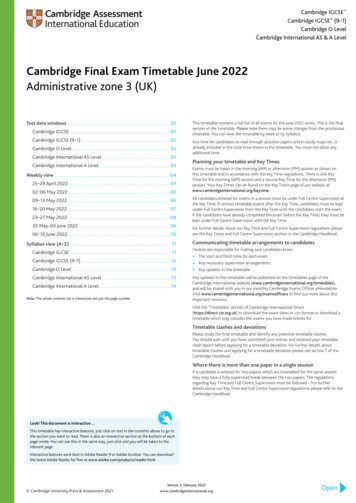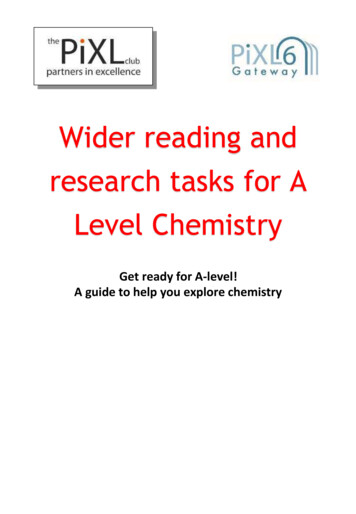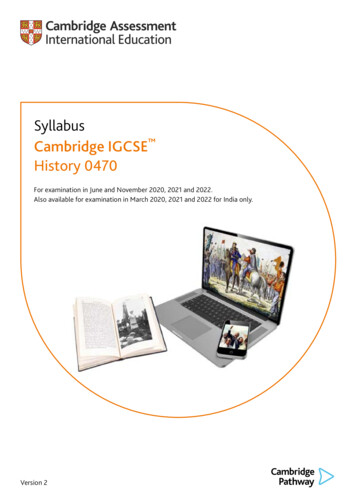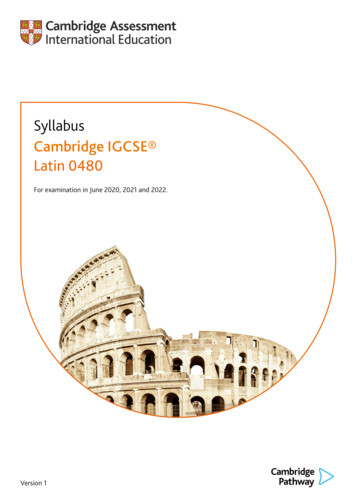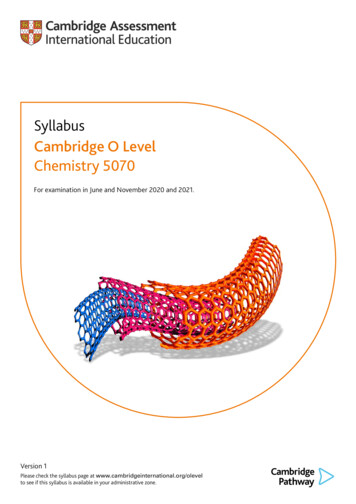
Transcription
SyllabusCambridge O LevelChemistry 5070For examination in June and November 2020 and 2021.Version 1Please check the syllabus page at www.cambridgeinternational.org/olevelto see if this syllabus is available in your administrative zone.
Changes to the syllabus for 2020 and 2021The syllabus has been updated. The latest syllabus is version 1, published September 2017.Significant changes to the syllabus are indicated by black vertical lines either side of the text.You are strongly advised to read the whole syllabus before planning your teaching programme.Any textbooks endorsed to support the syllabus for examination from 2017 are still suitable foruse with this syllabus.Teachers should take account of the changes described above when using these textbooks.Cambridge Assessment International Education is part of the Cambridge Assessment Group. Cambridge Assessment isthe brand name of the University of Cambridge Local Examinations Syndicate (UCLES), which itself is a department of theUniversity of Cambridge.UCLES retains the copyright on all its publications. Registered centres are permitted to copy material from this booklet fortheir own internal use. However, we cannot give permission to centres to photocopy any material that is acknowledged to athird party even for internal use within a centre.
Contents1. Introduction. 21.11.21.31.4Why choose Cambridge International?Why choose Cambridge O Level?Why choose Cambridge O Level Chemistry?How can I find out more?2. Teacher support. 52.1 Support materials2.2 Endorsed resources2.3 Training3. Assessment at a glance. 64. Syllabus aims and assessment objectives. 84.14.24.34.4Syllabus aimsAssessment objectivesWeighting for assessment objectivesNomenclature, units and significant figures5. Syllabus content. 116. Practical assessment. 266.1 Paper 3: Practical Test6.2 Paper 4: Alternative to Practical6.3 Practical techniques6.4 Apparatus6.5 Reagents list6.6 Guidance for the preparation of reagents7. Appendix. 317.1 Qualitative Analysis Notes7.2 The Periodic Table of Elements7.3 Glossary of terms used in science papers8. Other information. 35
Introduction1.Introduction1.1Why choose Cambridge International?Cambridge Assessment International Education prepares school students for life, helping them develop aninformed curiosity and a lasting passion for learning. We are part of the University of Cambridge.Our international qualifications are recognised by the world’s best universities and employers, givingstudents a wide range of options in their education and career. As a not-for-profit organisation, we devoteour resources to delivering high-quality educational programmes that can unlock learners’ potential.Our programmes and qualifications set the global standard for international education. They are createdby subject experts, rooted in academic rigour and reflect the latest educational research. They provide astrong platform for students to progress from one stage to the next, and are well supported by teaching andlearning resources.Every year, nearly a million Cambridge learners from 10 000 schools in 160 countries prepare for their futurewith an international education from Cambridge International.Cambridge learnersOur mission is to provide educational benefit through provision of international programmes andqualifications for school education and to be the world leader in this field. Together with schools, wedevelop Cambridge learners who are: confident in working with information and ideas – their own and those of others responsible for themselves, responsive to and respectful of others reflective as learners, developing their ability to learn innovative and equipped for new and future challenges engaged intellectually and socially, ready to make a difference.RecognitionCambridge O Level is internationally recognised by schools, universities and employers as equivalent indemand to Cambridge IGCSE (International General Certificate of Secondary Education). There are over700 000 entries a year in nearly 70 countries. Learn more at www.cambridgeinternational.org/recognitionSupport for teachersA wide range of materials and resources is available to support teachers and learners in Cambridge schools.Resources suit a variety of teaching methods in different international contexts. Through subject discussionforums and training, teachers can access the expert advice they need for teaching our qualifications. Moredetails can be found in Section 2 of this syllabus and at www.cambridgeinternational.org/teachersSupport for exams officersExams officers can trust in reliable, efficient administration of exams entries and excellent personal supportfrom our customer services. Learn more at idge O Level Chemistry 5070. Syllabus for examination in 2020 and 2021.
IntroductionOur systems for managing the provision of international qualifications and education programmesfor learners aged 5 to 19 are certified as meeting the internationally recognised standard for qualitymanagement, ISO 9001:2008. Learn more at www.cambridgeinternational.org/ISO90011.2 Why choose Cambridge O Level?Cambridge O Levels have been designed for an international audience and are sensitive to the needs ofdifferent countries. These qualifications are designed for students whose first language may not be Englishand this is acknowledged throughout the examination process. The Cambridge O Level syllabus also allowsteaching to be placed in a localised context, making it relevant in varying regions.Our aim is to balance knowledge, understanding and skills in our programmes and qualifications to enablestudents to become effective learners and to provide a solid foundation for their continuing educationaljourney.Through our professional development courses and our support materials for Cambridge O Levels, weprovide the tools to enable teachers to prepare students to the best of their ability and work with us in thepursuit of excellence in education.Cambridge O Levels are considered to be an excellent preparation for Cambridge International AS & A Levels,the Cambridge AICE (Advanced International Certificate of Education) Diploma, Cambridge Pre-U, and othereducation programmes, such as the US Advanced Placement program and the International BaccalaureateDiploma programme. Learn more about Cambridge O Levels at www.cambridgeinternational.org/olevelGuided learning hoursCambridge O Level syllabuses are designed on the assumption that learners have about 130 guided learninghours per subject over the duration of the course, but this is for guidance only. The number of hours requiredto gain the qualification may vary according to local curricular practice and the students’ prior experience ofthe subject.1.3 Why choose Cambridge O Level Chemistry?Cambridge O Levels are established qualifications that keep pace with educational developments andtrends. The Cambridge O Level curriculum places emphasis on broad and balanced study across a widerange of subject areas. The curriculum is structured so that students attain both practical skills andtheoretical knowledge.Cambridge O Level Chemistry is recognised by universities and employers throughout the world as proofof knowledge and understanding. Successful Cambridge O Level Chemistry candidates gain lifelong skills,including: a better understanding of the technological world in which they live, and take an informed interest inscience and scientific developments knowledge of the basic principles of chemistry through a mix of theoretical and practical studies an understanding of the scientific skills essential for further study at Cambridge InternationalAS & A Level, and skills which are useful in everyday life how science is studied and practised, and an awareness that the results of scientific research can haveboth good and bad effects on individuals, communities and the environment.Cambridge O Level Chemistry 5070. Syllabus for examination in 2020 and 2021.3
IntroductionCandidates may also study for a Cambridge O Level in a number of other science subjects including physicsand biology. In addition to Cambridge O Levels, Cambridge also offers Cambridge IGCSE and CambridgeInternational AS & A Levels for further study in both chemistry as well as other science subjects. Seewww.cambridgeinternational.org for a full list of the qualifications you can take.Prior learningWe recommend that candidates who are beginning this course should have previously studied a sciencecurriculum such as that of the Cambridge Lower Secondary Programme or equivalent national educationalframeworks. Candidates should also have adequate mathematical skills for the content contained in thissyllabus.ProgressionCambridge O Levels are general qualifications that enable candidates to progress either directly toemployment, or to proceed to further qualifications.Candidates who are awarded grades C to A* in Cambridge O Level Chemistry are well prepared to followcourses leading to Cambridge International AS and A Level Chemistry, or the equivalent.1.4 How can I find out more?If you are already a Cambridge schoolYou can make entries for this qualification through your usual channels. If you have any questions, pleasecontact us at info@cambridgeinternational.orgIf you are not yet a Cambridge schoolLearn about the benefits of becoming a Cambridge school at www.cambridgeinternational.org/startcambridgeEmail us at info@cambridgeinternational.org to find out how your organisation can register to become aCambridge school.4Cambridge O Level Chemistry 5070. Syllabus for examination in 2020 and 2021.
Teacher support2.Teacher support2.1 Support materialsYou can go to our public website at www.cambridgeinternational.org/olevel to download current andfuture syllabuses together with specimen papers or past question papers, examiner reports and gradethreshold tables from one series.For teachers at registered Cambridge schools a range of additional support materials for specific syllabusesis available online from the School Support Hub. Go to www.cambridgeinternational.org/support(username and password required). If you do not have access, speak to the Teacher Support coordinator atyour school.2.2 Endorsed resourcesWe work with publishers who provide a range of resources for our syllabuses including print and digitalmaterials. Resources endorsed by Cambridge International go through a detailed quality assurance processto make sure they provide a high level of support for teachers and learners.We have resource lists which can be filtered to show all resources, or just those which are endorsed byCambridge International. The resource lists include further suggestions for resources to support teaching.See centre for further information.2.3 TrainingWe offer a range of support activities for teachers to ensure they have the relevant knowledge and skills todeliver our qualifications. See www.cambridgeinternational.org/events for further information.Cambridge O Level Chemistry 5070. Syllabus for examination in 2020 and 2021.5
Assessment at a glance3.Assessment at a glanceFor Cambridge O Level Chemistry, candidates take three components: Paper 1 and Paper 2 and eitherPaper 3 or Paper 4.Paper 1: Multiple Choice1 hour40 compulsory multiple-choice questions. A copy of the Periodic Table is provided as part of thispaper (see Appendix).40 marksPaper 2: Theory1 hour 30 minutesThis paper has two sections.Section A has compulsory, structured questions of variable mark value. 45 marks in total are availablefor this section.Section B has four questions to choose from and candidates must answer three. Each question isworth 10 marks.A copy of the Periodic Table is provided as part of this paper (see Appendix).75 marksPaper 3: Practical Test1 hour 30 minutesDetails of the syllabus and requirements for thispaper are given in section 6.Candidates may not refer to notebooks,textbooks or any other information during thepractical examination.Paper 4: Alternative to Practical1 hourA written paper of compulsory short-answerand structured questions designed to testfamiliarity with laboratory practical procedures.Further details are given in section 6.Qualitative Analysis Notes are provided.Qualitative Analysis Notes are not provided.40 marks scaled to a mark out of 3060 marks scaled to a mark out of 30AvailabilityThis syllabus is examined in the June and November examination series.This syllabus is available to private candidates. However, it is expected that private candidates learn in anenvironment where practical work is an integral part of the course. Candidates will not be able to performwell in this assessment or progress successfully to further study without this necessary and importantaspect of science education.Detailed timetables are available from www.cambridgeinternational.org/timetablesAll Cambridge schools are allocated to one of six administrative zones. Each zone has a specific timetable.From 2020 this syllabus is not available in all administrative zones. To find out about the availability visit thesyllabus page at www.cambridgeinternational.org/olevel6Cambridge O Level Chemistry 5070. Syllabus for examination in 2020 and 2021.
Assessment at a glanceCombining this with other syllabusesCandidates can combine this syllabus in an examination series with any other Cambridge Internationalsyllabus, except: Cambridge IGCSE Physical Science (0652) Cambridge IGCSE Combined Science (0653) Cambridge IGCSE Co-ordinated Sciences (Double) (0654) Cambridge O Level Combined Science (5129) syllabuses with the same title at the same level.Please note that Cambridge O Level, Cambridge IGCSE and Cambridge IGCSE (9–1) syllabuses are at thesame level.Cambridge O Level Chemistry 5070. Syllabus for examination in 2020 and 2021.7
Syllabus aims and assessment objectives4.Syllabus aims and assessment objectives4.1 Syllabus aimsThe aims of the syllabus, which are not listed in order of priority, are to:1. provide, through well designed studies of experimental and practical chemistry, a worthwhileeducational experience for all students, whether or not they go on to study science beyond this leveland, in particular, to enable them to acquire sufficient understanding and knowledge to1.1 become confident citizens in a technological world, able to take or develop an informed interest inmatters of scientific import;1.2 recognise the usefulness, and limitations, of scientific method and to appreciate its applicability inother disciplines and in everyday life;1.3 be suitably prepared for studies beyond Cambridge O Level in pure sciences, in applied sciences orin science-dependent vocational courses.2. develop abilities and skills that:2.1 are relevant to the study and practice of science;2.2 are useful in everyday life;2.3 encourage efficient and safe practice;2.4 encourage effective communication.3. develop attitudes relevant to science such as:3.1 concern for accuracy and precision;3.2 objectivity;3.3 integrity;3.4 enquiry;3.5 initiative;3.6 inventiveness.4. stimulate interest in and care for the local and global environment.5. promote an awareness that:5.1 the study and practice of science are co-operative and cumulative activities, and are subject tosocial, economic, technological, ethical and cultural influences and limitations;5.2 the applications of sciences may be both beneficial and detrimental to the individual, the communityand the environment.8Cambridge O Level Chemistry 5070. Syllabus for examination in 2020 and 2021.
Syllabus aims and assessment objectives4.2 Assessment objectivesThe assessment objectives describe the knowledge, skills and abilities that candidates are expected todemonstrate at the end of the course. They reflect those aspects of the aims that are assessed.AO1 Knowledge with understandingCandidates should be able to demonstrate knowledge and understanding in relation to:1. scientific phenomena, facts, laws, definitions, concepts and theories2. scientific vocabulary, terminology and conventions (including symbols, quantities and units)3. scientific instruments and apparatus, including techniques of operation and aspects of safety4. scientific quantities and their determination5. scientific and technological applications with their social, economic and environmental implications.Syllabus content defines the factual material that candidates may be required to recall and explain.Questions testing these objectives will often begin with one of the following words: define, state, describe,explain or outline (see the glossary of terms in section 7.3).AO2 Handling information and solving problemsCandidates should be able, in words or using symbolic, graphical and numerical forms of presentation, to:1. locate, select, organise and present information from a variety of sources2. translate information from one form to another3. manipulate numerical and other data4. use information to identify patterns, report trends and draw inferences5. present reasoned explanations for phenomena, patterns and relationships6. make predictions and hypotheses7. solve problems.These assessment objectives cannot be precisely specified in the syllabus content because questionstesting such skills may be based on information that is unfamiliar to the candidate. In answering suchquestions, candidates are required to use principles and concepts that are within the syllabus and applythem in a logical, deductive or reasoned manner to a new situation. Questions testing these skills will oftenbegin with one of the following words: predict, suggest, calculate or determine (see the glossary of terms insection 7.3).AO3 Experimental skills and investigationsCandidates should be able to:1. follow a sequence of instructions2. use techniques, apparatus and materials3. make and record observations, measurements and estimates4. interpret, evaluate and report upon observations and experimental results5. design/plan an investigation, select techniques, apparatus and materials6. evaluate methods and suggest possible improvements.The apparatus and techniques that candidates should be familiar with are given in part 1 of the syllabuscontent and in the section on practical assessment. See also Appendix.Cambridge O Level Chemistry 5070. Syllabus for examination in 2020 and 2021.9
Syllabus aims and assessment objectives4.3 Weighting for assessment objectivesTheory papers (Papers 1 and 2)AO1 K nowledge with understanding is weighted at approximately 65% of the marks for each paper, withapproximately half allocated to recall.AO2 Handling information and solving problems is weighted at approximately 35% of the marks for eachpaper.Practical assessment (Papers 3 and 4)This is designed to test appropriate skills in assessment objective AO3 and carries approximately 20% of themarks for the qualification.4.4 Nomenclature, units and significant figuresNomenclatureThe proposals in ‘Signs, Symbols and Systematics’ (The Association for Science Education Companionto 16–19 Science)’ will generally be adopted, although the traditional names sulfate, sulfite, nitrate, nitrite,sulfurous and nitrous acids will be used in question papers. Sulfur (and all compounds of sulfur) will be speltwith f, not ph.To avoid difficulties arising out of the use of L as the symbol for litre, use of dm3 in place of L or litre will bemade.In accordance with current ASE convention, decimal markers in examination papers will be a single dot onthe line. Candidates are expected to follow this convention in their answers.Units, significant figuresIn practical work, candidates will be expected to use SI units or, where appropriate, units approved by theBIPM for use with the SI (e.g. minute). A list of SI units and units approved for use with the SI may be foundin the SI brochure at http://www.bipm.org. The use of imperial/customary units such as the inch anddegree Fahrenheit is not acceptable and should be discouraged. In all examinations, where data is suppliedfor use in questions, candidates will be expected to use units that are consistent with the units supplied, andshould not attempt conversion to other systems of units unless this is a requirement of the question.Candidates should give all answers to an appropriate number of significant figures and quantities shouldhave an appropriate unit. Marks will be awarded for these skills.10Cambridge O Level Chemistry 5070. Syllabus for examination in 2020 and 2021.
Syllabus content5.Syllabus contentIt is expected that any course in chemistry will be based on experimental work. Teachers are encouragedto develop appropriate practical work for candidates to facilitate a greater understanding of the subject.Candidates should be aware of the hazards and the appropriate safety precautions to follow when handlingequipment and reagents in experimental work.Teachers are reminded that, in the written papers, some of the marks are allocated to the higher ‘thinking’skills of AO2. In almost every section of the syllabus, candidates should be given practice at dealing withunfamiliar situations so that these higher thinking skills can be developed.It is important that, throughout the course, attention should be drawn to:(i) the finite life of the world’s resources and economic and environmental issues relating to recycling,renewable energy and conservation;(ii) economic considerations in the chemical industry, such as the availability and cost of raw materials andenergy;(iii) the social, environmental, health and safety issues relating to the use of chemicals in the laboratory, inthe home and in industry;(iv) the importance of chemicals in industry and in everyday life.Cambridge O Level Chemistry 5070. Syllabus for examination in 2020 and 2021.11
Syllabus content1Experimental chemistryContent1.1 Experimental design1.2 Methods of purification and analysis1.3 Identification of ions and gasesIt is expected that any course in chemistry will be based on experimental work. Teachers are encouragedto develop appropriate practical work for candidates to facilitate a greater understanding of the subject.Candidates should be aware of the hazards and appropriate safety precautions to follow when handling thereagents mentioned in this section.Learning outcomesCandidates should be able to:1.1 Experimental design(a) name appropriate apparatus for the measurement of time, temperature, mass and volume, includingburettes, pipettes, measuring cylinders and gas syringes(b) suggest suitable apparatus, given relevant information, for a variety of simple experiments, includingcollection of gases and measurement of rates of reaction1.2 Methods of purification and analysis(a) describe methods of purification by the use of a suitable solvent, filtration and crystallisation,distillation and fractional distillation, with particular references to the fractional distillation of crude oil,liquid air and mixtures of liquids(b) suggest suitable methods of purification, given information about the substances involved(c) describe paper chromatography and interpret chromatograms including comparison with ‘known’samples and the use of Rf values(d) explain the need to use locating agents in the chromatography of colourless compounds(e) deduce from given melting point and boiling point information, the identities of substances and theirpurity(f) explain that the measurement of purity in substances used in everyday life, e.g. foodstuffs anddrugs, is important1.3 Identification of ions and gases(a) describe the use of aqueous sodium hydroxide and aqueous ammonia to identify the followingaqueous cations: aluminium, ammonium, calcium, chromium( III ), copper( II ), iron( II ), iron( III ) andzinc (formulae of complex ions are not required)(b) describe tests to identify the following anions: carbonate (by the addition of dilute acid andsubsequent use of limewater); chloride (by reaction of an aqueous solution with nitric acid andaqueous silver nitrate); iodide (by reaction of an aqueous solution with nitric acid and aqueoussilver nitrate); nitrate (by reduction with aluminium and aqueous sodium hydroxide to ammonia andsubsequent use of litmus paper), sulfate (by reaction of an aqueous solution with nitric acid andaqueous barium nitrate), and sulfite (by warming with dilute acid)(c) describe tests to identify the following gases: ammonia (using damp red litmus paper); carbondioxide (using limewater); chlorine (using damp litmus paper); hydrogen (using a burning splint);oxygen (using a glowing splint) and sulfur dioxide (using acidified potassium manganate( VII ))(d) describe a chemical test for water12Cambridge O Level Chemistry 5070. Syllabus for examination in 2020 and 2021.
Syllabus content2The particulate nature of matterContent2.1 Kinetic particle theory2.2 Atomic structure2.3 Structure and properties of materials2.4 Ionic bonding2.5 Covalent bonding2.6 Metallic bondingLearning outcomesCandidates should be able to:2.1 Kinetic particle theory(a) describe the solid, liquid and gaseous states of matter and explain their interconversion in terms ofthe kinetic particle theory and of the energy changes involved(b) describe and explain evidence for the movement of particles in liquids and gases (the treatment ofBrownian motion is not required)(c) explain everyday effects of diffusion in terms of particles, e.g. the spread of perfumes and cookingaromas; tea and coffee grains in water(d) state qualitatively the effect of molecular mass on the rate of diffusion and explain the dependenceof rate of diffusion on temperature(e) state qualitatively and explain the effects of temperature and pressure on the volumes of gases2.2 Atomic structure(a) state the relative charges and approximate relative masses of a proton, a neutron and an electron(b) describe, with the aid of diagrams, the structure of an atom as containing protons and neutrons(nucleons) in the nucleus and electrons arranged in shells (energy levels) (no knowledge of s, p, dand f classification will be expected; a copy of the Periodic Table will be available in Papers 1 and 2)(c) define proton number and nucleon number(d) interpret and use symbols such as126C(e) define the term isotopes(f) deduce the numbers of protons, neutrons and electrons in atoms and ions from proton and nucleonnumbers2.3 Structure and properties of materials(a) describe the differences between elements, compounds and mixtures(b) compare the structure of simple molecular substances, e.g. methane, iodine, with those of giantcovalent substances, e.g. sand (silicon dioxide), diamond, graphite in order to deduce their properties(c) compare the bonding and structures of diamond and graphite in order to deduce properties suchas electrical conductivity, lubricating or cutting action (candidates will not be required to draw thestructures)(d) deduce the physical and chemical properties of substances from their structures and bonding andvice versaCambridge O Level Chemistry 5070. Syllabus for examination in 2020 and 2021.13
Syllabus content2.4 Ionic bonding(a) describe the formation of ions by electron loss/gain in order to obtain the electronic configuration ofan inert gas(b) describe the formation of ionic bonds between metals and non-metals, e.g. NaCl; MgCl2(c) state that ionic materials contain a giant lattice in which the ions are held by electrostatic attraction,e.g. NaCl (candidates will not be required to draw diagrams of ionic lattices)(d) relate the physical properties (including electrical property) of ionic compounds to their latticestructure2.5 Covalent bonding(a) describe the formation of a covalent bond by the sharing of a pair of electrons in order to gain theelectronic configuration of an inert gas(b) describe, using dot-and-cross diagrams, the formation of covalent bonds between non-metallicelements, e.g. H2; Cl2; O2; HCl; N2; H2O; CH4; C2H4; CO2(c) deduce the arrangement of electrons in other covalent molecules(d) relate the physical properties (including electrical properties) of covalent compounds to theirstructure and bonding2.6 Metallic bonding(a) describe metallic bonding as the electrostatic attraction between positive ions in a lattice and a ‘seaof electrons’(b) relate the malleability of metals to their structure and the electrical conductivity of metals to themobility of the electrons in the structure14Cambridge O Level Chemistry 5070. Syllabus for examination in 2020 and 2021.
Syllabus content3Formulae, stoichiometry and the mole conceptCandidates should be able to:(a) state the symbols of the elements and formulae of the compounds mentioned in the syllabus(b) deduce the formulae of simple compounds from the relative numbers of atoms present and vice versa(c) deduce the formulae of ionic compounds from the charges on the ions present and vice versa(d) interpret and construct chemical equations, with state symbols, including ionic equations(e) define relative atomic mass, A r(f) define relative molecular mass, Mr , and calculate relative molecular mass (and relative formula mass) asthe sum of relative atomic m
6 Cambridge O Level Chemistry 5070. Syllabus for examination in 2020 and 2021. 3. Assessment at a glance For Cambridge O Level Chemistry, candidates take three components: Paper 1 and Paper 2 and either Paper 3 or Paper 4. Paper 1: Multiple Choice 1 hour 40 compulsory multiple-choice questions. A copy of the Periodic Table is provided as part .


